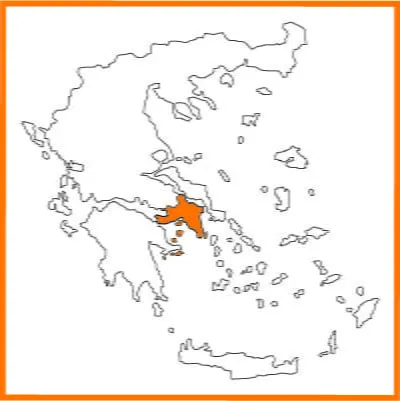Attica has held significant importance in Greece throughout its history, dating back to ancient times. Its earliest settlement dates to the Neolithic Age, with King Kekropas being its inaugural ruler, responsible for establishing its initial 12 municipalities.
The heart of Attica was the Acropolis, which witnessed the actions of many notable figures. By the 5th century BC, the number of municipalities had expanded to 100, marking a pinnacle in its cultural development. Athens, the city within Attica, rose to prominence as a formidable state, thanks to the formation of the First Athenian Alliance. Even following its defeat in the Peloponnesian War, the region continued to thrive, undeterred. Neither the Macedonian nor Roman periods could halt this progress.
However, from the 3rd century onwards, Attica faced numerous barbarian raids. During the Byzantine era, it played a peripheral role in historical events. The period of Turkish occupation inflicted irreparable damage upon the region.
In 1833, Attica was liberated and became an integral part of the Greek state. It was during this time that Athens was chosen as the capital of Greece
Attica includes major cities that have been known since ancient times, such as Athens, Piraeus, Eleusis, Megara, Lavrio, Sounion, and Marathon. It is connected to the Peloponnese by the Isthmus of Corinth.
The prefect of Attica today includes some islands of the Aegean Sea: Aegina, Salamis, Hydra, Spetses, Kythira, and Antikythera, each of which is historical of great importance to the history of Attica as well as Greece more broadly, both in ancient times and Greece’s recent history.
Attica’s history is closely related to the history of Athens, and in particular of 5th century BCE Athens, the “Golden Age” of the classical period. In the 2nd century BCE, Attica became a Roman province, followed later by Byzantine, Venetian, and then Ottoman rule. In 1821, a successful revolution against the Ottomans began and from 1829, Athens was chosen as the capital of the newly-formed Greek state.
Attica is one of the most blessed regions of Greece: with a temperate climate and surrounded by mountains, it is protected from extreme weather conditions; it enjoys a high level of sunshine and an extended coastline so that the sea breezes meet the easterly, northerly and westerly winds to ensure a healthy atmosphere for both residents and crops.
In addition to its unique natural, historical and cultural heritage, the land of Attica is notable for its primary products, with a variety of nutritional goods and dishes. All of Attica abounds in nutritional products with an exceptional production of crops like peanuts, figs, olive oil, citrus fruits, garden vegetables, and aromatic-therapeutic herbs, as well as products of animals like dairy, meat (sheep, goats, and poultry), honey seafood from fishing and fish farming.
The Gastronomic Identity of Attica
The cuisine of Attica, apart from all kinds of roast meat which has roots from ancient times, has been shaped by the influence of immigrants from the shores of Asia Minor, the Pontus region and Constantinople (Istanbul), north Epirus (part of modern-day Albania) and later during the post-war period from almost all the regions of Greece, who all settled in the capital in search of a better life. The locally produced meat is mainly from sheep and goats which graze on the aromatic herbs that cover the mountain slopes of Attica (sage, thyme, oregano, rosemary, wort, wild parsley, etc.), resulting in a particular flavoursome meat.
Among Attica’s most interesting dishes are those of Arvanite (north Epirus) origin which spread to the Mesogeia, western Attica, and to parts of the Peloponnese and Euboea, such as different pies, tiganopsomo (pan-fried bread), strifopita (a twisted pita stuffed with cheese or greens), tiropita, hortopita, all with homemade filo and special cheeses. There are also the famous tzolies or goglies, similar to the Italian gnocchi, served either alone with grated cheese or with baked cockerel.
From Pontus, we have peinirli which is prevalent in the northern suburbs (Drosia, Stamata, and neighbouring areas where Pontic immigrants settled).
An iconic dish of Attica is ‘Athenian salad fish mayonnaise’, boiled fish (grouper or sea bream) with herbs, carrots and potatoes, capers and pickled gherkins. The fish is cleaned and its flesh is dressed with homemade mayonnaise and chopped vegetables, while its original shape is preserved by keeping the fish head whole for serving.
Among the traditional sweets of urban Athens is Copenhagen, with Danish roots (from the reign of King George I), a rich sweet with a base of almonds, filo crust or biscuit pastry, generously covered with enough syrup to send anyone for a cholesterol test!
The wines of Attica – Retsina
In the broader region of Mesoghia, where vineyards are traditionally cultivated, the ancients worshipped Dionysos, while its modern inhabitants continue to produce exceptional wines, as well as the renowned Mesoghian retsina under ideal conditions for viticulture in a 6,500 ha vineyard. Modern wineries respect the age-old winemaking tradition and indigenous superior quality varieties such as Savatiano will take you on a unique palatable journey across Attica. The history of the Attican vineyards goes hand in hand with good quality, while modern technology helps to enhance the production of fine wines. Many wineries are open to visitors.
Retsina is the traditional Greek wine and Attica its birthplace. According to archaeological finds and countless written accounts regarding its production and consumption, retsina, has been steadily produced for thousands of years. The main reasons for the use of pine resin used were to seal the mouth of amphorae (ancient ceramic vessels used for storage and transportation of wine). Today retsina wine is produced by the addition of the natural resin extracted from pine trees (commonly known as Aleppo Pine) during fermentation of white and, in rare cases, of rosé wines. The main grape variety used in the production of retsina is Savatiano and, to a lesser degree, Rhoditis. Premium quality retsina carries the characteristic balsamic aroma of pine which, however, does not inhibit grape aromas. The imperceptible sense of bitterness leaves a refreshing aftertaste akin to that of a carbonated refreshment, and makes retsina the ideal companion of the flavorful dishes of traditional Greek cuisine. Only retsina produced in Greece can carry the indication of “Traditional Designation”.
Protected Designation of Origin (PDO) and Protected Geographical Indication (PGI) products of Attica:
| Protected Designation of Origin (PDO) and Protected Geographical Indication (PGI) products of Attica: | ||
| Product | Designation of Origin or Geographical indication | Regional unit |
| Fruits, dried nuts | Pistachio of Aigina (PDO) | Attica |
| Fruits, dried nuts | Pistachio of Megara (PDO) | Attica |
| Cheese | Feta (PDO) | Attica |
| Wine | Anavissos (PGI) | Attica |
| Wine | Attica (PGI) | Attica |
| Wine | Vilitsa (PGI) | Attica |
| Wine | North slopes of mount Pendeli (PGI) | Attica |
| Wine | Gerania (PGI) | Attica |
| Wine | Ilion (PGI) | Attica |
| Wine | Koropi (PGI) | Attica |
| Wine | Markopoulo (PGI) | Attica |
| Wine | Paiania (PGI) | Attica |
| Wine | Pallini (PGI) | Attica |
| Wine | Spata (PGI) | Attica |
| Wine | Slopes of Kitheronas (PGI) | Attica |
| Retsina | Attica (PGI) | Attica |
| Retsina | Mesogeia (PGI) | Attica |
| Retsina | Koropi (PGI) | Attica |
| Retsina | Markopoulo (PGI) | Attica |
| Retsina | Megara (PGI) | Attica |
| Retsina | Paiania (PGI) | Attica |
| Retsina | Pallini (PGI) | Attica |
| Retsina | Pikermi (PGI) | Attica |
| Retsina | Spata (PGI) | Attica |




